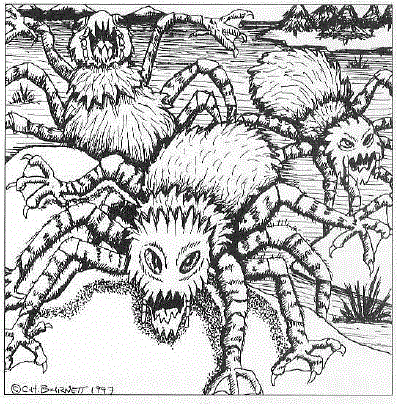
| Climate/Terrain: | Any subarctic |
|---|---|
| Frequency: | Rare |
| Organization: | Pack |
| Activity Cycle: | Any except midday |
| Diet: | Carnivore |
| Intelligence: | Low (5-7) |
| Treasure: | O,Q |
| Alignment: | Neutral |
| No. Appearing: | 5-15 |
| Armor Class: | 6 (Queen, 4) |
| Movement: | 15, swim 12 (Queen, 12, swim 8) |
| Hit Dice: | 4+3 (Queen, 6+ 1) |
| THAC0: | 15 |
| No. of Attacks: | 1 |
| Damage/Attack: | 1-3 and acid |
| Special Attacks: | Impaling |
| Special Defenses: | Surprise and camouflage |
| Magic Resistance: | 35% (Queen, 50%) |
| Size: | S (2½' tall) |
| Morale: | Elite-14 (Queen, Fanatic-18) |
| XP Value: | 975 (Queen, 1,400) |
Snow spiders look like muscular, furry, eight-legged arachnids, but they are warm-blooded mammals who stalk the forests and tundra of the north. Their fur is white on the head and back, and striped pale grey or brown along the legs, making the perfect camouflage in snowy regions. Two almond-shaped pale blue or amber eyes, a mouth of razor sharp teeth, and a large upright head with a flexible neck like that of an owl distinguish them further from true spiders. Snow spiders' furry feet have three clawed toes facing forward and one back. Webbing between the toes helps them cross snow drifts, and they are excellent swimmers.
Combat: Snow spiders are cunning predators, hunting in packs of 5-15. The hours just before dawn and right after sunset are their preferred times to hunt. Snow spiders may choose between two different attacks, biting and impaling. While their bite causes only 1- 3 hp damage, their acidic saliva causes an additional 1-6 hp corrosive damage. A victim who successfully saves vs. poison suffers half damage. However, the snow spider's favorite attack is impaling. Sheathed within the heel of each foot is a 3'-long spike of bone. When prey is in range, the spider leaps forward, unsheathes its spikes, and strikes the victim feet-first, delivering 3d8 hp damage. Snow spiders can leap 10' vertically or 15' horizontally. The spikes are also used for climbing trees or rocky hillsides, and for securing their footing over ice.
A hunting pack works as a team, scouting ahead, setting ambushes, and attacking in concert. Snow spiders can make a deep resonant chining sound as a scare tactic, scattering members of a flock or herd into the rest of the waiting pack. When in their terrain and season, they have an 85% chance of going unseen. Their sense nf smell and hearing is average, but they have keen eyesight and receive a +1 bonus to their surprise roll.
Snow spiders' fur is flammable, and the creatures suffer double damage against normal fires. They still retain their magic resistance bonus against magical fires, plus any saving throws allowed. Non-magical cold does not affect them.
Habitat/Society: Snow spiders live in cold regions where snow is on the ground for most of the year. They make their homes in well-hidden burrow dens dug deep into rocky hillsides. During the summer months, they go into a state of semi-hibernation, coming out a few times during the season at night. Temperatures over 50°F make snow spiders sluggish, raising their AC to 8 and slowing their movement rate to 8. In the colder months, the pack roams for days looking for prey.
Packs consist only of males; the only female is the queen. She is larger and slower than the males, has thicker skin, and lacks the camouflage markings on the legs. She digs the den for the pack while they bring her food. The queen never leaves the vicinity of the den and spends her life guarding and enlarging the den and rearing the young. Twice a year, the queen gives birth to one or two kits. Males are raised within the den for one year, whereupon they join the pack. Female kits are usually taken from the den into the wilderness to die. There are two exceptions. When a pack reaches approximately 20 members, the queen raises the next female born. After one year, the female young and several younger males strike out to start a pack of their own. The other exception is when the queen reaches old age. When the queen feels tier time waning, she produces a single female kit. After the kit matures, the young female kills the queen and eat her, thus becoming the new queen. The old queen does not fight her offspring, and the males do not partake in the feast. This is not the only instance of cannibalism within the pack. When food is very scarce, the pack turns on the weakest male, killing and eating him.
Snow spiders communicate with a clicking, chirring sound as well as a simple sign language used during hunting. Because of physical limitations, they cannot speak another language but can be taught to understand one.
All treasure found in the lair is incidental, coming from victims that have been dragged to the lair for consumption.
Ecology: Locals sometimes collect the saliva of a spider to use as an acid. However, they are difficult to capture and more di"fficult to keep. Snow spiders do not eat anything that they did not kill. A single snow spider does not survive well in captivity, as it relies heavily on the social interaction of the pack. The captive spider curls up in a corner, refusing to move or take live prey, and eventually starves itself to death.
